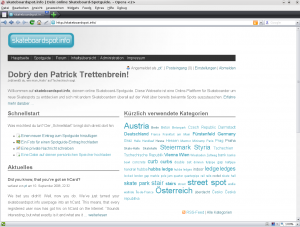Browser Configuration/Opera/de: Difference between revisions
(Created page with "Starten Sie '''Opera''' und rufen Sie die folgende Adresse auf:") |
(Created page with "Dieses Tutorial erklärt, wie Sie '''Opera''' so einrichten können, dass es sich gut in die anderen Anwendungen von '''Plasma''' eingliedert.
Dafür müssen wir das Skin des ''...") |
||
| Line 1: | Line 1: | ||
<languages /> | <languages /> | ||
Dieses Tutorial erklärt, wie Sie '''Opera''' so einrichten können, dass es sich gut in die anderen Anwendungen von '''Plasma''' eingliedert. | |||
Dafür müssen wir das Skin des ''Opera Oxygen Project'' installieren, '''Opera''' so konfigurieren, dass es das Farbschema des Plasma-Desktop verwendet, und '''Operas''' Schriften denen von KDE anpassen. | |||
{{Note|1=This tutorial is written for Opera 10 or later. Make sure that you're using Plasma's default icon theme, Oxygen, since the Opera Oxygen Project skin uses icons from Oxygen.}} | {{Note|1=This tutorial is written for Opera 10 or later. Make sure that you're using Plasma's default icon theme, Oxygen, since the Opera Oxygen Project skin uses icons from Oxygen.}} | ||
Revision as of 00:09, 30 December 2010
Dieses Tutorial erklärt, wie Sie Opera so einrichten können, dass es sich gut in die anderen Anwendungen von Plasma eingliedert. Dafür müssen wir das Skin des Opera Oxygen Project installieren, Opera so konfigurieren, dass es das Farbschema des Plasma-Desktop verwendet, und Operas Schriften denen von KDE anpassen.
== Schritt 1: Das Skin installieren
Starten Sie Opera und rufen Sie die folgende Adresse auf:
http://my.opera.com/community/customize/skins/info/?id=8141
Click to install the skin.
Step 2: Applying the Skin & Changing the Color Scheme
Go to .
In the Skins box, you will see a list of all the skins that are currently installed. Click on to apply the Opera Oxygen Project skin to Opera.
Click on the menu box next to Color Scheme and select to let Opera use KDE's color scheme.
Step 3: Changing the Font
Go to . Click on the tab.
Opera has two default fonts - the normal font and the monospace font. You can change these default fonts by clicking on them. Change the normal font to DejaVu Sans and change the monospace font to DejaVu Sans Mono.
That's it! Now Opera will look and feel just like your Plasma applications.

Source
This tutorial is based on Patrick Trettenbrein's blog entry entitled “How to make Opera 9.5 look native in KDE 4”. Additional updates have been made as Opera has been updated.


